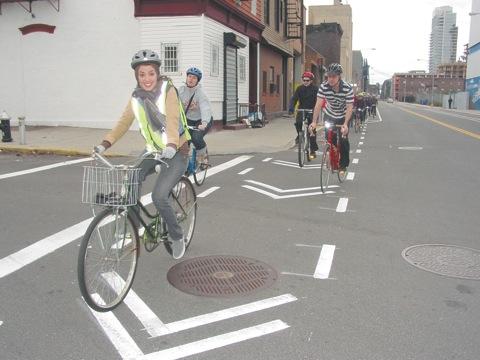The tentative compromise regarding the controversial bike lanes on Kent Avenue that leaked out last week has drawn praise from involved parties.
According to government officials, the deal calls for the southbound lane of traffic on Kent Avenue between Clymer and N. 14th streets to be removed. Under the plan, the two−way bike lanes that currently flank both sides of the street both will be moved to the west side of the street along that stretch.
In between the bike lanes and the northbound lane of traffic would be a buffer comprised of plantings, but with room to accommodate some parking spaces and loading zones for businesses. On the other side of the traffic lane will be another lane dedicated to parking and loading zones, government officials said.
Allocating these two lanes for parking and loading zones address complaints of the businesses and residents who have protested to the lanes when they were first installed in October as a prelude to the eventual Brooklyn Greenway, an ambitious network of landscaped lanes envisioned to surround Brooklyn’s perimeter in the future.
Business owners complained that the lanes threaten their businesses by making deliveries all but impossible. Residents, concentrated mostly on the southern portion of Kent Avenue, have said the lanes make parking impossible and generally disrupt their lifestyle.
The new proposal, officials said, would restore around 75 percent of the curb space for parking and loading that was lost when the lanes were first installed.
Government officials said the plan hinges on the approval of Community Board 1.
“We will be sharing our ideas for improving the configuration of Kent Avenue with the community over the next few weeks and we look forward to working with them to refine our plans,” said DOT spokesperson Seth Solomonow.
Government officials said that two rumored consequences of reconfiguring Kent Avenue – that Wythe Avenue will become a truck route, and that the Bedford Avenue bike lanes would be removed – will not happen.
Sources close to the negotiations said Rep. Nydia Velazquez, who is helping to fund the Greenway with federal monies, was instrumental in leaning on the DOT to come to a palatable solution.
In February, she said she would press the DOT to remove a lane of parking. When asked why it took so long for her idea to be agreed to by the DOT as a working proposal, she said pointedly, “Sometimes bureaucrats are stubborn.”
Even if it is soon approved by CB1, it will probably take some time for the proposal to be implemented. A government official said the earliest the new configuration could be installed is late summer.
Still, those who protested the lanes were happy that any solution may be at hand.
“We are excited that the NYC DOT has committed to meet directly with the local businesses and craft a plan that addresses their various needs,” wrote Leah Archibald, executive director of EWVIDCO, the North Brooklyn advocacy group, in an e−mail statement.
CB1 Transportation Chair Teresa Toro said the proposed solution would improve pedestrian safety along Kent Avenue by making the distance to cross the street shorter. Having only one lane of traffic would also serve as a “traffic calming” device that would reduce the speed of vehicles down the Avenue.
However, Toro expressed concern that the reconceived median might undermine the concept of a Greenway, which she characterized as “a planted median, as opposed to a median with some planters.”

























